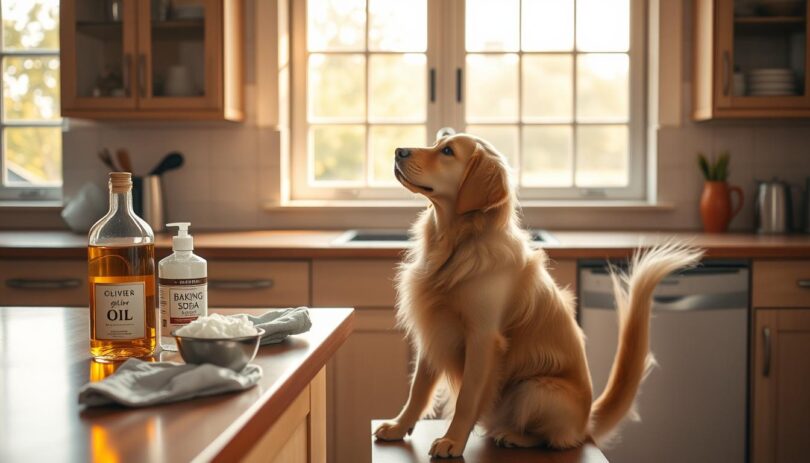Watching your furry companion drag themselves across the floor can stir up worry and confusion. You’re not alone—many pet owners notice this behavior and wonder what’s causing their pup’s discomfort. Often, it’s a sign of irritation that needs gentle care.
Veterinary experts highlight three common triggers: anal gland problems, food sensitivities, and parasites like worms. These issues create persistent itching or pain, leading pets to seek relief through scooting. Ignoring the behavior could worsen underlying conditions, so timely action matters.
Thankfully, many solutions don’t require a vet visit. Simple adjustments to meals, grooming routines, or safe topical treatments often ease symptoms. For example, adding fiber to diets or using warm compresses can address glandular blockages naturally.
This guide shares practical, vet-approved strategies to soothe your companion. You’ll learn how to identify causes, apply at-home methods, and prevent future flare-ups. Every tip prioritizes safety, ensuring your pet feels better without unnecessary stress.
Understanding Dog Scooting: Causes and Concerns
Seeing your four-legged friend drag their rear across surfaces often sparks concern. While the behavior may seem odd, it usually signals discomfort requiring attention. Two primary factors drive this action: biological processes and external irritants.
Anal Gland Complications and Impaction
Dogs have small sacs near their rectum called anal glands. These normally release fluid during bowel movements to mark territory. When blocked or infected, the glands swell, creating pressure. Pets may then scoot to relieve the discomfort.
Allergies, Parasites, and Digestive Issues
Food sensitivities or environmental allergens can inflame a pet’s skin. Parasites like tapeworms also irritate the anal area. Both scenarios trigger persistent itching, leading to frequent scooting. Monitoring stool quality helps identify digestive problems.
Persistent rear-dragging warrants a veterinarian visit. Professionals can rule out infections or chronic conditions. Early intervention prevents minor issues from escalating.
Recognizing Signs of Discomfort in Your Dog
Sudden changes in your pet’s behavior might signal they need your help. While occasional rear-dragging isn’t always alarming, consistent patterns paired with other symptoms often point to deeper discomfort. Observing these clues early helps address problems before they escalate.
Behavioral Changes and Visible Irritations
Excessive licking around the anal region is a common warning sign. Pets may also scoot more frequently than usual or appear restless during rest. These actions suggest persistent itching or soreness in sensitive areas.
Visible redness or swelling near the anus confirms irritation. Dull fur or flaky skin in that area could indicate allergies or infections. If basic cleaning doesn’t resolve these symptoms, underlying issues may require targeted care.
When Scooting Becomes Worrisome
Persistent scooting after improved hygiene practices demands attention. Pets showing appetite changes, lethargy, or unusual aggression might face chronic conditions. At this stage, natural solutions may not suffice.
Tracking behavior shifts helps determine when professional guidance becomes necessary. While gentle methods often work, prolonged discomfort warrants a vet visit to rule out infections or gland complications.
Home Remedies for Dog Scooting: Natural Relief Options
Addressing anal discomfort in pets requires methods that combine simplicity with effectiveness. Two approaches stand out for their ability to provide relief while supporting long-term wellness. Let’s explore safe techniques to manage irritation and promote comfort.
Utilizing a Warm Water Compress
A warm compress improves circulation to the affected area, easing swelling and tenderness. Start by soaking a clean cloth in water heated to skin temperature—test it on your wrist first. Gently press it against the irritated skin for 3-5 minutes, repeating twice daily.
Expressing Anal Glands Safely at Home
Manual gland expression requires caution to avoid injury. Wear disposable gloves and apply a pet-safe lubricant. Position your thumb and forefinger at 4 and 8 o’clock around the anus. Apply light pressure upward and inward to release fluid.
Clean the area thoroughly afterward to prevent infection. If resistance occurs or your pet shows distress, stop immediately. Persistent blockages may need professional treatment to avoid complications.
These methods can ease mild cases when performed carefully. However, recurring issues or signs of infection—like unusual discharge—require veterinary guidance. Monitoring bowel movements helps track improvements in gland function over time.
Diet and Lifestyle Adjustments for Anal Gland Health
Nutritional choices directly impact your companion’s comfort and gland health. Tailoring meals to support digestive regularity can alleviate pressure on anal sacs, reducing the urge to scoot. Small changes often yield significant improvements without disrupting routines.
High-Fiber Foods and Pumpkin Benefits
Fiber-rich diets promote firmer stools, which naturally express anal sacs during bowel movements. Canned pumpkin (unsweetened) is a vet-approved option—its soluble fiber absorbs excess moisture in the digestive tract. Experts recommend adding 1-2 tablespoons per meal for medium-sized pets.
Hydration, Probiotics, and Balanced Nutrition
Proper water intake prevents stool hardening, which strains glands on either side of the rectum. Consider mixing warm water into dry kibble or offering broth-based treats. Probiotic supplements support gut flora balance, lowering risks of food allergies linked to itching.
Always consult a veterinarian before altering your pet’s diet. They can identify specific triggers, like poultry or grains, that might worsen anal sac issues. If dietary shifts don’t resolve scooting within 2-3 weeks, schedule a follow-up visit. Persistent symptoms could indicate infections needing targeted care.
Grooming and Hygiene: Maintaining a Clean Anal Area
Proper grooming routines play a vital role in preventing discomfort around your pet’s sensitive areas. A clean, well-trimmed anal region minimizes debris buildup and lowers risks of recurrent irritation. This practice also helps spot early signs of parasites or allergic reactions before they escalate.
Regular Grooming Practices and Fur Trimming
Long fur near the anus traps moisture and waste, creating breeding grounds for bacteria. Trim hair around the area every 3-4 weeks using rounded scissors. Focus on keeping the coat short enough to allow airflow while avoiding accidental nicks.
Check for matted fur during grooming sessions. These tangles can pull on the skin, worsening gland inflammation. Gentle brushing afterward removes loose hairs that might otherwise irritate the glands.
Using Specialized Wipes and Topical Soothers
Hypoallergenic wipes formulated for pets cleanse without harsh chemicals. Use them after walks or bowel movements to remove allergens or parasites. Look for ingredients like aloe vera or chamomile to calm inflamed skin.
For persistent itching, apply vet-approved balms containing oatmeal or coconut oil. These create a protective barrier while reducing redness. Avoid human products—their pH levels often clash with animal skin.
Combining these steps with other home-based strategies supports gland health long-term. If redness persists despite consistent care, consult your veterinarian to rule out infections or chronic allergies.
When to Seek Professional Veterinary Help
While many pet owners successfully manage minor issues with care routines, some situations demand expert intervention. Recognizing critical signals early ensures your companion receives timely support for lasting wellness.
Warning Signs and Persistent Symptoms
Persistent swelling near the anal area or visible blood in stool requires immediate attention. These symptoms often indicate infections, parasites, or gland impactions needing targeted treatment. Changes in appetite paired with lethargy suggest systemic issues affecting overall health.
If frequent scooting continues despite improved grooming or dietary adjustments, consult a veterinarian. Professionals use specialized tests to identify hidden causes like severe allergies or intestinal disorders. Delaying care risks complications, including abscesses or chronic pain.
Consulting Your Veterinarian for Underlying Issues
Veterinarians assess hydration levels, food sensitivities, and skin conditions through comprehensive exams. They might recommend fecal tests to detect parasites or bloodwork to uncover inflammation markers. This approach addresses root reasons rather than just surface symptoms.
Before visiting, track behavior patterns, water intake, and bowel movements. Detailed notes help practitioners make accurate diagnoses faster. While natural methods support recovery, advanced cases often require prescription medications or gland expression procedures.
Prioritizing professional guidance safeguards long-term health. Early action prevents minor concerns from evolving into costly emergencies, ensuring your pet maintains comfort and vitality.
The Role of Supplements and Specialized Products
When simple adjustments aren’t enough, targeted solutions can bridge the gap between basic care and lasting relief. Veterinarians often recommend specialized formulas designed to address gland health while supporting digestive balance. These products combine scientific research with natural ingredients for holistic results.
Vet-Recommended Options Like Glandex Chews
Supplements like Glandex Chews contain fiber blends and probiotics to promote regular bowel movements. Ingredients like pumpkin seed powder help naturally express anal sacs during digestion. Daily use supports stool consistency, reducing strain on glands over time.
Using Topical Sprays for Immediate Relief
Soothing sprays with hydrocortisone or chamomile calm irritated skin quickly. These products temporarily numb itchy areas, breaking the cycle of scooting. Pair them with hypoallergenic wipes to remove allergens without drying delicate skin.
Integrating these solutions into routines is simple—mix powders into meals or offer chews as treats. When combined with a balanced diet and consistent grooming, they help prevent flare-ups before discomfort starts. Always choose options backed by clinical studies to ensure safety and efficacy.
A Final Word on Caring for Your Scooting Dog
Managing anal discomfort requires teamwork between attentive owners and veterinary professionals. Recognizing triggers like blocked glands or food sensitivities early helps address irritation before it escalates. Simple strategies—fiber-rich diets, gentle hygiene routines, and monitoring bowel movements—support comfort while preventing recurring issues.
Combining daily care with vet consultations ensures balanced solutions. While targeted supplements or warm compresses ease symptoms, persistent scooting often signals deeper concerns needing expert evaluation. Tracking your pet’s movements and skin reactions helps identify patterns that guide effective treatment plans.
Proactive care reduces risks of complications. Schedule checkups if improvements stall, and prioritize vet-recommended products for lasting relief. Trusted resources and timely action empower owners to safeguard their companion’s well-being confidently.
Remember: gentle at-home methods paired with professional vet guidance create the safest path forward. Addressing discomfort promptly leads to happier pets and peace of mind for those who love them.
FAQ
What are the most common reasons dogs drag their rear on the floor?
Anal gland impaction, allergies, parasites like tapeworms, or digestive problems often cause discomfort. Swollen anal sacs or food sensitivities can also trigger scooting behavior.
How can a warm compress help relieve anal gland irritation?
Applying a clean, warm washcloth to the area for 5–10 minutes softens built-up fluid, reduces swelling, and eases discomfort. Pair this with gentle massage near the glands for better results.
Are there dietary changes that support anal gland health?
Adding fiber-rich foods like canned pumpkin (not pie filling) or vet-approved probiotics promotes regular bowel movements, which naturally express glands. Ensure fresh water is always available to prevent dehydration-related constipation.










Leave a Comment